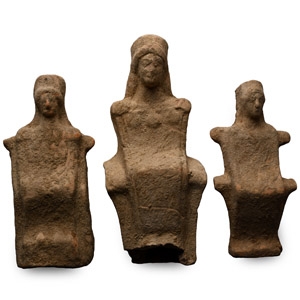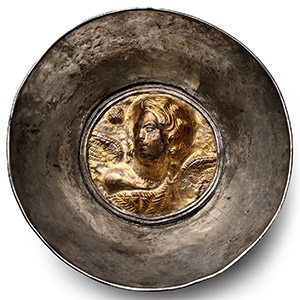Home > Auctions > 9 - 17 September 2025
Ancient Art, Antiquities, Books, Natural History & Coins
with H.A.C., Basel, prior 1999.
This lot is accompanied by an illustrated lot declaration signed by the Head of the Antiquities Department, Dr Raffaele D'Amato.
Cf. Biers, W.R., The Archaeology of Greece. An Introduction, Ithaca-London, 1987, fig.8.63, p.236, for similar.
UK private collection before 2000.
Acquired on the UK art market.
Private collection, London, UK.
This lot has been cleared against the Art Loss Register database, and is accompanied by an illustrated lot declaration signed by the Head of the Antiquities Department, Dr Raffaele D'Amato.
For the ring type, see Boardman, J., Greek gems and finger rings, London, 2001, plate 217, item IX; Marshall, F.H., Catalogue of the Jewellery, Greek, Etruscan and Roman, in the Department of Antiquities, British Museum, London, 1911, items x-xii.
Swiss private collection, 1987.
Private collection, London.
This lot has been checked against the Interpol Database of stolen works of art and is accompanied by a search certificate number no.12859-241328.
This lot has been cleared against the Art Loss Register database, and is accompanied by an illustrated lot declaration signed by the Head of the Antiquities Department, Dr Raffaele D'Amato.
See Hellmuth, A., Da Esti A Ovest: Le Tombe Principesche degli Sciti, in Bonora, G.L. and Marzatico, F., Ori dei Cavalieri delle Steppe, Milan, 2007, p.175, pl.13.
Private collection, Mainz, Germany, 1980s.
Acquired by the current owner from the above, 2006.
Accompanied by a copy of a seven page examination report number 114/2019 by Dr Habil Mikhail Treister.
This lot has been checked against the Interpol Database of stolen works of art and is accompanied by search certificate number no.12764-237139.
This lot has been cleared against the Art Loss Register database, and is accompanied by an illustrated lot declaration signed by the Head of the Antiquities Department, Dr Raffaele D'Amato.
Cf. Carter, M.L., Arts of the Hellenized East, Precious Metalwork and Gems of the Pre-Islamic Era, London, 2015, for discussion; cf. Marazov, I. edn., Ancient Gold: The Wealth of the Thracians. Treasures from the Republic of Bulgaria, New York, 1998.
Nike was the winged goddess of victory. Goat-skin clothing was an attribute of Artemis, but here it is worn by Nike, attesting to the syncretic nature of the art embodied by this object. The workmanship of this piece suggests a local workshop in the Kuban basin.
From the private collection of the late R Priday, Brookman Hall, Hertfordshire, UK; thence by descent.
This lot has been checked against the Interpol Database of stolen works of art and is accompanied by search certificate number no.12808-240846.
This lot has been cleared against the Art Loss Register database, and is accompanied by an illustrated lot declaration signed by the Head of the Antiquities Department, Dr Raffaele D'Amato.
Cf. Matoušková, M., ‘The Sacral Knot and Its Iconographic Use’, in Studia Hercynia, XXII/2, 9-31, fig.12, for similar seals.
From an old London, UK, collection formed before 1975.
Property of a Middlesex, UK, gentleman antiquarian.
This lot is accompanied by an illustrated lot declaration signed by the Head of the Antiquities Department, Dr Raffaele D'Amato.
Cf. Michael C. Carlos Museum, object no. 2010.013.001; Ashmolean Museum, AN1938.761.
From the private collection of Mr K.A., acquired in the 1990s-early 2000s.
This lot is accompanied by an illustrated lot declaration signed by the Head of the Antiquities Department, Dr Raffaele D'Amato.
Cf. Chadour, A.B., Rings. The Alice and Louis Koch Collection, volume I, Leeds, 1994, item 43, for type; cf. also Torelli, M., Gli Etruschi, Monza, 2000, p.455, for similar.
Egyptian-style scarabs and scaraboids were characteristic of Etruscan art from the 8th century B.C. Originally made in Phoenicia, Cyprus or Rhodes, these objects were made of faience, blue paste, glass paste and bone, or semi-precious stones of varying hardness, from steatite to quartz, onyx and jasper. Mounted in settings on revolving pendants of precious metal, which were later imitated by Etruscan goldsmiths, these Egyptianising items performed prophylactic-religious functions, through the use of sacred or magical imagery taken from hieroglyphic language: royal names or titles, theonyms, sacred symbols, and auspicious formulas.
European private collection, 1980s.
Private collection, acquired on the German art market in 2001.
This lot has been cleared against the Art Loss Register database, and is accompanied by an illustrated lot declaration signed by the Head of the Antiquities Department, Dr Raffaele D'Amato.
From an old London, UK, collection since circa 1985.
This lot is accompanied by an illustrated lot declaration signed by the Head of the Antiquities Department, Dr Raffaele D'Amato.
Franz Heger (1853–1931), Austrian traveller and ethnographer, acquired in the Caucasus during his 1890 expedition.
Believed to have been gifted circa 1930 to Franz Hancar (1893–1968), noted scholar and expert in ancient Caucasian cultures.
Thence by descent, acquired in the 1950s by Mr R.D., Vienna.
Acquired from the above in 1998 by N.M., former Israeli Ambassador to Austria (1998–2000).
Accompanied by a copy of a nine page examination report number 137/2015 by Dr Habil Mikhail Treister.
This lot has been checked against the Interpol Database of stolen works of art and is accompanied by a search certificate number no.12861-240722.
This lot has been cleared against the Art Loss Register database, and is accompanied by an illustrated lot declaration signed by the Head of the Antiquities Department, Dr Raffaele D'Amato.
See Salmony, A., ‘An unknown Scythian find in Novocherkassk’ in Eurasia Septentrionalis Antiqua, 1936, X, pp.54-60; Loehr, M., ‘The Stag Image in Scythia and the Far East’ in Archives of the Chinese Art Society of America Volume 9, 1955, pp.63-76; Galanina, L.K. & Grach, N., Scythian Art, Leningrad, 1986; Leskov, A.M.,Grabschätze der Adygeen, Munich, 1990; Schiltz, V., Die Skythen und andere Steppenvölker, Munich, 1994; Jacobson, E., The Art of the Scythians; the interpenetration of cultures at the edge of the Hellenic World, Leiden, New York & Cologne, 1995; Galanina, L.K., Die Kurgane von Kelermes: “Königsgräber” der frühskythischen Zeit, Moscow, 1997; Галанина, Л.К., ‘Конское снаряжение из коллекции елизаветинских древностей, хранящихся в Государственном Эрмитаже (раскопки Н.И. Веселовского 1914, 1915, 1917 гг.)’ in АСГЭ. Вып.38. Санкт-Петербург.: Государственный Эрмитаж, Saint Petersburg, 2010. pp.107-122; the closest parallel to the standard finial is a pair of bronze top-poles with the same iconographical scheme, kept in the Museum of Novocherkassk (Salmony, 1936, pp.54-55, fig.1).
This piece resembles a pair of bronze finials discovered in 1913, now in the Museum of Novocherkassk. However, there are notable differences: the Novocherkassk examples have paired birds at the top rather than a single bird, and lack antlers or suspended bells. Experts have dated the Novocherkassk pieces to around 500-400 BC. This example, though unique, shares key stylistic traits, particularly the scrollwork antlers with other bronze horse gear fittings and finials found in the Kuban Basin, many securely dated to the 4th century BC based on associated amphora finds. Comparable decorative styles such as bands of oblique lines appear on horse harnesses from known Scythian burial sites. This, along with the concentration of similar finds in the Kuban region, supports the idea that this finial also originated there. Scholars have suggested that finials like this symbolise the Tree of Life, especially when birds are present. The bird at the top of this piece may reflect that idea. Similar imagery appears on a bronze finial from Alexandropol and another from Lysaya Gora, the latter depicting the Scythian god Papaeus (akin to Zeus). While exact dating is difficult due to lack of archaeological context, stylistic parallels suggest a 4th century BC origin is most likely. Its unusual combination of sculpted and openwork elements, along with its symbolic imagery, makes it a rare and important example of Scythian or Maiotian bronze craftsmanship.
Acquired in the late 1980s-early 1990s.
Private collection, London, UK.
This lot is accompanied by an illustrated lot declaration signed by the Head of the Antiquities Department, Dr Raffaele D'Amato.
Cf. similar item in the British Museum, London, under accession no.1896,0724.1.
Acquired in the late 1980s-early 1990s.
Private collection, London, UK.
This lot is accompanied by an illustrated lot declaration signed by the Head of the Antiquities Department, Dr Raffaele D'Amato.
Cf. Boucher, S., Tassinari, S., Bronze Antiques du Musée de la civilisation Gallo-Romaine a Lyon, 1. Inscriptions, Statuaire, Vaisselle, Lyon, 1976, nos.20-21, 38 (Fortuna and Isis-Fortuna).
49 - 60 of 3897 LOTS



.jpg)

.jpg)
.jpg)
.jpg)
.jpg)


.jpg)
.jpg)



